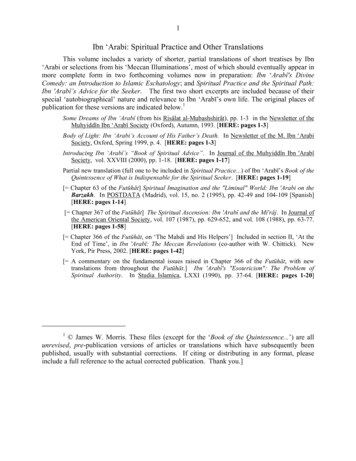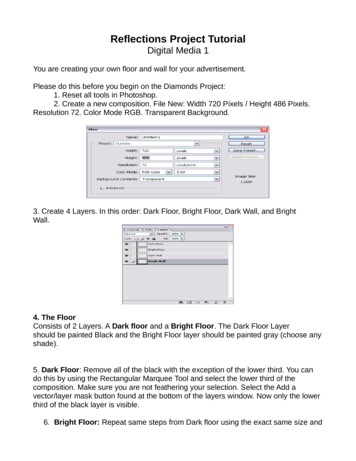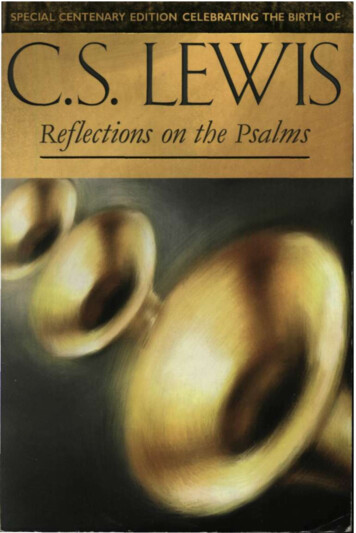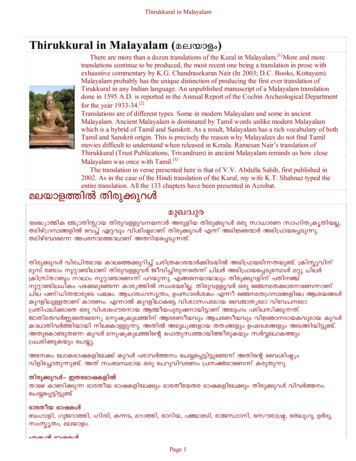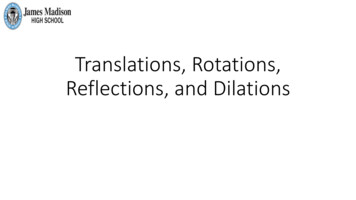
Transcription
Translations, Rotations,Reflections, and Dilations
In geometry, atransformation is a wayto change the positionof a figure.
In some transformations, the figureretains its size and only its position ischanged.Examples of this type of transformationare:translations, rotations, and reflectionsIn other transformations, such asdilations, the size of the figure willchange.
TRANSLATION
TRANSLATIONA translation is a transformation thatslides a figure across a plane or throughspace.With translation all points of a figuremove the same distance and the samedirection.
TRANSLATIONBasically, translation means that a figurehas moved.An easy way to remember whattranslation means is to remember A TRANSLATION IS A CHANGE IN LOCATION.A translation is usually specified by adirection and a distance.
TRANSLATIONWhat does a translation look like?originalimagexyTranslate from x to yA TRANSLATION IS A CHANGE IN LOCATION.
TRANSLATIONIn the example below triangle A is translated tobecome triangle B.ABDescribe the translation.Triangle A is slide directly to the right.
TRANSLATIONIn the example below arrow A is translated tobecome arrow B.ABDescribe the translation.Arrow A is slide down and to the right.
ROTATION
ROTATIONA rotation is a transformation that turns afigure about (around) a point or a line.Basically, rotation means to spin a shape.The point a figure turns around is calledthe center of rotation.The center of rotation can be on oroutside the shape.
ROTATIONWhat does a rotation look like?center of rotationA ROTATION MEANS TO TURN A FIGURE
ROTATIONThis is anotherThe trianglewaywasrotationrotatedaround thepoint.lookscenter of rotationA ROTATION MEANS TO TURN A FIGURE
ROTATIONIf a shape spins360 , how far doesit spin?This is called360 .
ROTATION Rotating a shape 180 turns a shape upsidedown.If a shape spins180 , how far doesit spin?This is called a.180
ROTATIONIf a shape spins 90 ,how far does itspin?90 This is called a.
ROTATIONDescribe how the triangle A was transformed tomake triangle BABDescribe the translation.Triangle A was rotated right 90
ROTATIONDescribe how the arrow A was transformed to makearrow BBADescribe the translation.Arrow A was rotated right 180
ROTATIONWhen some shapes are rotated theycreate a special situation calledrotational symmetry.to spin a shapethe exact same
ROTATIONAL SYMMETRYA shape has rotational symmetry if, afteryou rotate less than one full turn, it is thesame as the original shape.Here is an example 90 As this shape is rotated 360 , is itever the same before the shapereturns to its original direction?Yes, when it is rotated 90 it is thesame as it was in the beginning.So this shape is said to haverotational symmetry.
ROTATIONAL SYMMETRYA shape has rotational symmetry if, afteryou rotate less than one full turn, it is thesame as the original shape.Here is another example As this shape is rotated 360 , is itever the same before the shapereturns to its original direction?Yes, when it is rotated 180 it is thesame as it was in the beginning.180 So this shape is said to haverotational symmetry.
ROTATIONAL SYMMETRYA shape has rotational symmetry if, afteryou rotate less than one full turn, it is thesame as the original shape.Here is another example As this shape is rotated 360 , is itever the same before the shapereturns to its original direction?No, when it is rotated 360 it isnever the same.So this shape does NOT haverotational symmetry.
ROTATION SYMMETRYDoes this shape have rotational symmetry?Yes, when theshape is rotated120 it is thesame. Since 120 is less than 360 ,this shape HASrotationalsymmetry120
REFLECTION
REFLECTIONA reflection is a transformation that flipsa figure across a line.A REFLECTION IS FLIPPED OVER A LINE.
REFLECTIONAfter a shape is reflected, it looks like aRemember,itisthemirror image of itself.same, but it isbackwardsA REFLECTION IS FLIPPED OVER A LINE.
REFLECTIONThe line that a shape is flipped over iscalled a line of reflection.The line of reflection can beontheshapeLine of reflectionor it can be outside the shape.Notice, the shapes are exactly the samedistance from the line of reflection onboth sides.A REFLECTION IS FLIPPED OVER A LINE.
REFLECTIONDetermine if each set of figures shows a reflection or atranslation.ACBC’B’A’A REFLECTION IS FLIPPED OVER A LINE.
REFLECTIONSometimes, a figure hasreflectional symmetry.This means that it can be folded along a line ofreflection within itself so that the two halves of thefigure match exactly, point by point.Basically, if you can fold a shape in half and itmatches up exactly, it has reflectional symmetry.
REFLECTIONAL SYMMETRYAn easy way to understand reflectional symmetry is tothink about folding.What happens whenyou unfold the pieceof paper?Do you rememberfolding a piece ofpaper, drawing halfof a heart, and thencutting it out?
REFLECTIONAL SYMMETRYThe line of reflectionReflectionalSymmetrymeans that a shapecan be folded along aline of reflection sothe two haves of thefigure match exactly,point by point.Line of Symmetryin a figure withreflectionalsymmetry is called aline of symmetry.The two halves areexactly the same They aresymmetrical.The two halves makea whole heart.
REFLECTIONAL SYMMETRYThe line created by the fold is the line of symmetry.A shape can have more than one line of symmetry.Where is the line of symmetry for this shape?How can I foldthis shape sothat it matchesexactly?Line of Symmetry
REFLECTIONAL SYMMETRYHow many lines of symmetry does each shape have?Do you see a pattern?
REFLECTIONAL SYMMETRYWhich of these flags have reflectional symmetry?United States of AmericaCanadaMexicoEngland
CONCLUSIONWe just discussed three types of transformations.See if you can match the action with theappropriate OTATION
Translation, Rotation, and Reflection allchange the position of a shape, while thesize remains the same.The fourth transformation that we aregoing to discuss is called dilation.
DILATIONDilation changes the size of the shapewithout changing the shape.When you go to the eye doctor, theydilate you eyes. Let’s try it by turning offthe lights.When you enlarge a photograph or use acopy machine to reduce a map, you aremaking dilations.
DILATIONEnlarge means to make a shape bigger.Reduce means to make a shape smaller.The scale factor tells you how muchsomething is enlarged or reduced.
DILATIONNotice each time the shape transforms the shapestays the same and only the size changes.50%REDUCE200%ENLARGE
DILATIONLook at the pictures belowDilate the image with a scale factorof 75%Dilate the image with a scale factorof 150%
DILATIONLook at the pictures belowDilate the image with a scale factorof 100%Why is a dilation of 75% smaller, adilation of 150% bigger, and a dilation of100% the same?
Lets try to make sense of all of thisTRANSFORMATIONSCHANGE THE POSTIONOF A SHAPECHANGE THE SIZE OF ASHAPETRANSLATIONROTATIONREFLECTIONDILATIONChange inlocationTurn around apointFlip over alineChange size ofa shape
See if you can identify the transformation thatcreated the new shapesTRANSLATION
See if you can identify the transformation thatcreated the new shapesWhere is the lineof reflection?REFLECTION
See if you can identify the transformation thatcreated the new shapesDILATION
See if you can identify the transformation thatcreated the new shapesROTATION
See if you can identify the transformation in thesepictures?REFLECTION
See if you can identify the transformation in thesepictures?ROTATION
See if you can identify the transformation in thesepictures?TRANSLATION
See if you can identify the transformation in thesepictures?DILATION
See if you can identify the transformation in thesepictures?REFLECTION
ever the same before the shape returns to its original direction? Yes, when it is rotated 180 it is the same as it was in the beginning. So this shape is said to have 180 rotational symmetry. A shape has rotational symmetry i

